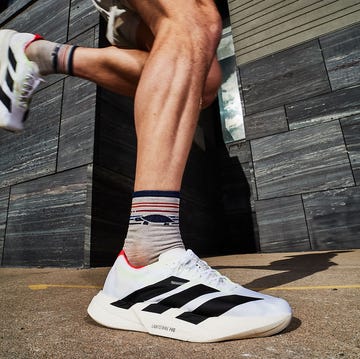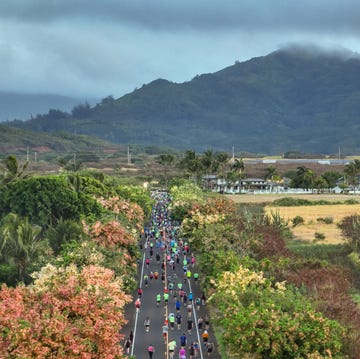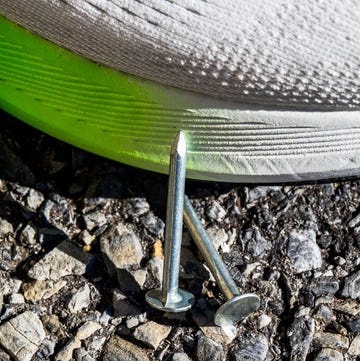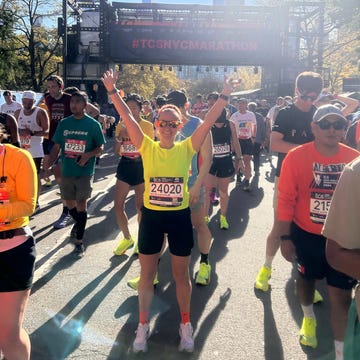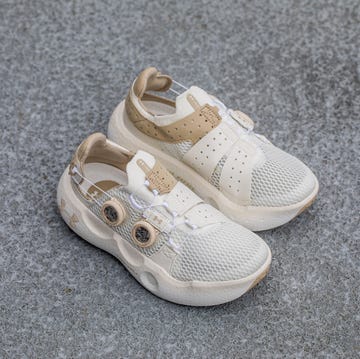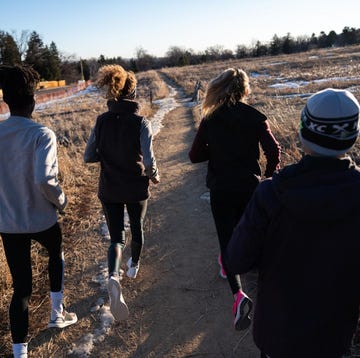Imagine a lone figure emerging from a sea of competitors, head tilted back slightly, limbs driving them forward like the pistons of a steam engine: elbows out, fists pumping at chest level, legs churning the earth below with long, rhythmic strides. Some runners bounce, some plod, and some lean, shoulders first, as if forcing themselves through a wall. This runner glides.
Now imagine their hands covered in blood. It curls up their forearms and leaves a trail of droplets on the pavement as they hammer one 5:40 mile after another. If they move fast enough, they might escape the metallic smell.
In reality, there is no blood. There is only the blur of screaming spectators, the backs of competitors yet to be caught and passed, the clock perched above yet another finish line, signaling to the runner that imagining blood has, yet again, helped them manifest a dream. It’s a dark image, born of anguish and fear, of feeling powerless and trapped. But for all its darkness, the image gives the runner a reason to run through pain. Because feeling pain is better than being numb; and on the other side of that pain, there is strength, and there is peace.
The runner’s name is Sofia Camacho, and in recent years the visual has become a vital part of their racing strategy. It helped them run a time of 2:41:23 at the 2023 California International Marathon in their debut attempt at the distance, and then a 2:31:29 at the 2024 New York City Marathon, where they shattered the nonbinary course record by 14 minutes and finished with a faster time than both Jenny Simpson and Aliphine Tuliamuk, two of the most decorated women in the pro field. Still, Camacho knew they could do better. Just a month after New York, the visual helped them run 2:29:15 in Valencia, Spain, good for 23rd in a women’s field stacked with elite runners from all over the world.
Camacho chose Valencia for its flatness and depth, knowing it would be the perfect race to set a personal best; but because Valencia doesn’t have a nonbinary division, Camacho had no choice but to register as a woman. It wasn’t the first time. From 2018 to 2022, Camacho ran Division I track and cross country for Columbia University’s women’s team. It never felt right, but running felt good, so they dealt with it.
Camacho assumed they’d have to keep dealing with it, even after they graduated and left the collegiate racing scene behind. Back then—which is to say, just a few years ago—nonbinary divisions were all but nonexistent. Now, they’re proliferating at races large and small across the United States. Jake Fedorowski, an advocate for nonbinary inclusion, keeps a tally on their website, nonbinaryrunning.com; as of January, the count stood at 338, though not all had been confirmed by race organizers. Participation is growing, too. In 2021, when the New York City Marathon added a nonbinary division, 15 people finished in that category. In 2024, there were 119. “There’s a lot of excitement and energy behind trying to show up and prove not only to ourselves but prove to the industry and to the world that you have to take us seriously,” Fedorowski told me.
We’ll come back to this. For now, let’s focus on Camacho. This is a story about them, and to borrow a line from Walt Whitman, they contain multitudes: elite athlete, drag performer, tattoo artist, run coach, activist. Mexican by heritage; New Yorker by choice; raised in Argentina and France. An Ivy Leaguer grinding it out in New York’s gig economy. A 25-year-old phenom whose star is only beginning to rise.
That last point can’t be overstated. In the past year, Camacho has either won or placed in the nonbinary division of every race they’ve run, and finished ahead of all the women in many of those races, too. Their range is extraordinary. Last May, they set a PR of 1:14:06 at the New York Road Runners’ Brooklyn Half, the largest half marathon in the U.S., with more than 28,000 finishers. Except for a lone Olympian, the entire women’s field finished behind Camacho. In July, they ran 16:15 at the Trials of Miles 5K on the Beach in Queens, where they beat the top female, a five-time All-American, by 16 seconds. A week later, they averaged 5:18 per mile to not only win the nonbinary division of the NYRR Team Championships, an intensely competitive five-mile race in Central Park, but to also beat the lead woman by 24 seconds.
And yet, when I began reporting this story last summer, I asked numerous women who run for some of New York’s top local clubs if the name Sofia Camacho meant anything to them, and only a handful said yes; even fewer knew of their success on the roads and track. That may be because Camacho is relatively new to the local competitive racing scene. But more so, one could argue, it’s because their name does not typically appear in women’s race results. As one of Camacho’s former coaches at Columbia, Candace Archer, put it, “They’re representing a group that’s not seen.”
If Camacho did race in the women’s division, they’d have helped secure multiple victories for their team, Brooklyn Track Club (BKTC), in last year’s New York Road Runners’ club points series. BKTC is full of women who ran D1 in college, and none are faster than Camacho. “We’re all just so amazed and impressed,” said Henna Rustami, who also ran for Columbia and is now a top athlete on BKTC. Another, Katherine Harrison, described Camacho as a “bird-boned aerobic machine.”
But for Camacho, local clout and team victories are beside the point. “If they’re respecting me as a runner, they’re going to have to respect me as a nonbinary person, and as a queer person,” Camacho said one afternoon last fall, as they were ramping up for New York.
That was then, before they’d won New York and smashed the 2:30 barrier. Before the blitz of postmarathon podcasts, news reports, and calls from prospective managers and agents. Now, runners and brands the world over know Camacho’s name, and the prospect of going pro is suddenly a real possibility.
There’s just one problem: despite the increasing opportunities for nonbinary runners at the amateur level, there is still no nonbinary division in professional running due to policies set by World Athletics. This means that Camacho has a choice to make: either continue dominating New York’s amateur running scene as the nonbinary athlete they are, or race internationally as a woman. And Camacho has never been a fan of the either/or.
Sofia Camacho was born in Florida, in 1999, to Mexican parents Francisco Camacho and Victoria Ferral. When Sofia was a baby, the family returned to Mexico City, where Francisco had a corporate job in the dairy industry; Victoria was a homemaker.
For as long as Sofia can remember, they longed to be small to the point of vanishing. Everywhere they went, they carried a bag full of art supplies. They loved to draw. One day at school Sofia drew a little girl under a rainbow. A classmate said she could draw a smaller one. Soon the two were competing to see who could draw the smallest little girl. Sofia drew a lot of little girls under a lot of little rainbows. They kept getting smaller.
For Sofia, life at home felt turbulent. If they did everything right, they wouldn’t make things worse, so they followed the rules, got straight A’s, and tried to take up as little space as possible. Victoria did her best, but Sofia felt little connection to her, let alone any desire to emulate her. Sofia never felt like a girl anyway. They knew that from the time they knew what being a girl meant—the pretty makeup, the hair, the dresses and dolls. But they weren’t a boy, either. Boys were gross.
When Sofia was 5, Francisco moved the family to Buenos Aires and then to Paris when Sofia was 14. By then the marriage had ended; Victoria went to Paris, too, but got her own place.
As a young teenager, Sofia was quiet and shy, and one of very few Mexicans at their private international school just outside Paris. They did make one friend: a girl Sofia admired for how bold she was, how pretty, how different from Sofia. She wore pajamas to school and brought boxed cereal to class. Soon they were getting hot chocolate and croissants after school. They’d hold hands, share a glance, sometimes give each other a little kiss. It felt right.
When Francisco and Victoria learned of the intimacy, they ordered Sofia to return straight home after school. Sofia was crushed but did as they were told. Alone in their bedroom, Sofia disappeared into art. They’d begun experimenting with face paint, and with so much time to practice, their creations became ever darker and more elaborate. By 15, they were posting tutorials on YouTube—the Cheshire Cat, Poison Ivy, Joker and Harley Quinn from the Batman movies.
At the end of sophomore year, Sofia’s history teacher, who doubled as the school’s track and cross-country coach, encouraged Sofia to join the team. A 2:40 marathoner himself, he knew that running required dedication and discipline as much as raw talent. He asked only the best students. Sofia had never been into sports, but they liked being hand-picked, and joining the team seemed like an interesting challenge, maybe even a chance to make some friends. They knew nothing about running, though; they wore basketball shorts to practice. Before long they were one of the fastest runners at the school.
The man appeared in Sofia’s life through running, and he seemed the perfect mentor: an amateur triathlete with training in sports massage and exercise science. He was 26 to Sofia’s 16, and he took a special interest in the young athlete. It began with giving Sofia proper running attire, helping them find a good physical therapist, and doing workouts together. It soon led to private massages to help Sofia with a hip impingement, and then to masking Sofia’s pain with tramadol. He said the pills were “like Tylenol.” To reassure Sofia that they were safe, he took them, too.
Sofia called him Namenick in their contacts, to keep his identity private. He lived in a cramped studio near Sofia’s school and began inviting Sofia over. They’d watch The Office and talk about their favorite movies. One day he caressed Sofia’s neck while they sat on his pullout sofa, Camacho says. Eventually, he slid a hand under their shirt, and later, their shorts. “It feels good, doesn’t it?” he’d ask. It did feel good, at least physically. Sofia had told him they liked girls, but maybe this is what friends do, they thought.
Namenick texted Sofia a lot. He’d flirt, make sexual innuendos, and plot how to meet without anyone finding out. He began ending his texts with a hashtag: #DGBTJ, for Don’t Get Busted ’Til June, when Sofia would be 18 and graduate from high school. Sometimes he’d add OAL: Or At All.
Tramadol made Sofia feel sluggish and slow, but Namenick insisted the pills would help them run through injury, and Sofia liked that they suppressed their appetite. So they kept taking them, kept getting smaller. Namenick’s own drug use didn’t stop at pills. He had forged prescriptions for amphetamine and morphine, and began asking Sofia to administer his injections. When Namenick would nod off, Sofia would stay to watch over him, fearing that if they left and he died, Sofia would be charged with murder. “If someone found him and I was the last one to see him, and my fingerprints are everywhere… yeah, I killed that man,” they reasoned.
One evening in the spring of Sofia’s senior year, Namenick led them to his refrigerator. Inside were bags of his own blood. He said he needed to give himself a transfusion—a kind of makeshift home-doping operation—and wanted Sofia’s help. “You know how in a movie, you’re like yelling at someone, ‘Just run’? It’s one of those moments,” Camacho says. But at that moment, they felt obligated to help. “I was like, that was my friend.”
It would take years for Camacho to recognize the full extent of Namenick’s abuse, and by then it felt too late to do anything about it. Namenick was an ocean away, the burden of proof was too great, and let’s face it, life moves on. What remains is the trauma. Camacho carries that in their bones.
In the fall of 2018, Camacho enrolled at Barnard College, the all-women’s liberal arts school within Columbia University. They didn’t have the race times to be recruited by a Division I school like Columbia, but Dan Ireland, the director of Columbia’s track and cross- country team, admired their determination. “I was just kind of taken by [them],” he says. Ireland told Camacho that if they could keep up with any of the women in workouts, then they could join as a walk-on. Camacho could keep up, but only barely, and they had trouble finding their place. They were the only Barnard student on the team, and as a non-recruit, Camacho hadn’t been invited to the preseason training camp where all the women had had a week to bond.
Namenick had flown to New York with Camacho to help them move into their dorm. After he returned to France, Camacho decided to stop taking tramadol for the first time in two years—unaware that it was an opioid with a higher risk of abuse than oxycodone and was on the World Anti-Doping Agency’s banned-substances list. They became nauseated and fatigued, achy and weak. They thought they had the flu. With no appetite for food, Camacho became so thin that the Columbia athletics department told them they’d have to sit out workouts and meets until they’d regained some weight.
Camacho again turned to art. Whenever they had time, they continued experimenting with face paint and posting tutorials on YouTube. In one, they transmogrify into Venom, Marvel Comics’ alien symbiote; in another, they attempt Nebula, the cyborg anti-hero of Marvel’s Guardians of the Galaxy.
With the benefits of time and distance, Camacho began to see their relationship with Namenick as oppressive and toxic, and broke things off in early 2019, halfway through freshman year. Namenick spiraled. Dozens of text messages and emails reveal a startling pattern of hostility and blackmail. In one, he said he was back in New York and demanded that Camacho stop pretending they didn’t want to see him; in another, he threatened to post terrible things about Camacho on Facebook if they wouldn’t agree to speak to him. “I guess it just sucks that I’m still in love with you,” he wrote. “Stop contacting me. Please. Just stop,” Camacho implored. It would be years before he did.
Throughout it all, Camacho kept running. On June 5, 2019, they posted a photo on Instagram of themselves running on the shoulder of an empty highway in Spain, and captioned it: “Thanks for saving my life 🖤💪🏻#globalrunningday.”
But social media, of course, isn’t reality, and running, as beneficial for mental health as it may be, is not therapy. In February 2020, halfway through sophomore year, Camacho attempted suicide and spent two weeks in a psychiatric hospital. Ireland remembers it as a time of near-constant struggle: injuries, dangerously low body weight, disordered eating. Ireland didn’t care that Camacho wasn’t the fastest runner on the team; they were one of his athletes, and he was responsible for their well-being. “We were like, okay, we’re going to see this through,” he says.
Then COVID-19 hit and Ireland didn’t see Camacho for 18 months. By then Camacho was living with their girlfriend, Bri, and began doing long, solo runs just north of New York City. When collegiate racing resumed in the fall of 2021, Camacho had transformed into one of the fastest runners on Columbia’s women’s team. Looking back, they attribute their turnaround largely to being away from their teammates, away from the pressure to fit their mold: feminine, heterosexual, gender-conforming.
Camacho became a team captain their senior year, and younger athletes began coming to them with questions about their own queerness or feelings of not fitting in. “I thought, okay, I have to keep running fast so that I can be someone that people can look up to,” Camacho says. That spring, they placed second in the Ivy League Championships 10,000 meters, in 34:53, and ran a 5K PR of 16:14. It remains on Columbia University’s top-10 all-time list for outdoor track.
Camacho graduated from Barnard with a degree in film studies in May 2022 and took an apprenticeship at a tattoo parlor in Hell’s Kitchen, on Manhattan’s West Side. They moved with Bri and their dog, a chiweenie named Boo, into a one-bedroom apartment downtown. But while the pandemic had allowed the couple to live a kind of fantasy together, the stressors of a reopened world would bring their relationship to an end. The tattoo studio was so poorly managed that going to work became a daily ordeal, and Camacho was still struggling emotionally in ways that Bri didn’t know how to handle. “It was a very weird, liminal space,” Camacho says of that time in their life.
And so, one cold night that December, Camacho sat down in front of a mirror, pulled out their face paint, and began to morph, for the first time, into a creation entirely their own.
It was a cool evening in mid-September. I arrived at a low-rise building on a quiet street in East Williamsburg, where blocks of prewar tenements are flecked with trendy cafés and artists’ lofts. Camacho was running late. They’d just worked a shift at Mile High Run Club, the group running franchise (think: SoulCycle with treadmills) where Camacho coaches three or more classes a week, and they had to do their makeup.
A young person in their early 20s with a delicate mustache, blue eyeshadow, and short-cropped hair let me inside. They introduced themselves as Maljo Blu, Camacho’s “drag sister,” and led me up a flight of stairs into a photographer’s studio, where a small group of friends sat on folding chairs in one corner of the room. Camacho and their new girlfriend, a drag artist who goes by the name Daniella Darling, had scheduled the photoshoot for promotional materials.
Camacho developed their drag persona, Xana Whoria, in private and then began going to drag shows in costume before finally working up the nerve to get on stage, in January 2023, at a drag competition in Brooklyn called Bitch Fest. A kind of Victorian harlot-clown who often performs in ripped fishnet stockings and blood-soaked corsets, with compound insect eyes and lifelike gaping wounds, Xana Whoria is everything Camacho never allowed themselves to be as a child: powerful, angry, big. Their choice of name offers catharsis: a play on zanahoria, the Spanish word for carrot; it’s Camacho’s way of reclaiming a period of disordered eating in which they consumed so many carrots their skin turned orange. Informed by Camacho’s Mexican heritage, Xana Whoria also pays tribute to traditions like Día de Los Muertos, the aesthetics of the painter Frida Kahlo, and folklore such as the tale of La Llorona, about a mother who drowns her own children. No two performances are alike; all command rapt attention from the audience.
Around 8:30, Xana slipped into the room, dropped their bag, and gave everyone a big hug. They hugged Daniella the longest. The two met in a subway station in June 2023, instantly hit it off, and now live and perform drag together as partners. “This one’s very modest,” Daniella told me, flashing Xana an adoring smile. Daniella, who identifies as trans-femme and uses she/her pronouns, described seeing Camacho find themselves in drag as “kind of magical.” As quiet as they can be in life, Daniella said, “on stage, they really open up.”
At one show last fall, Xana Whoria briefly set themselves on fire as they lip-synced to the mournful, post-rock song “Lanterns Lit” by Son Lux. At another, they stumbled across the stage in a tattered nightgown and a long, black wig as they took swigs from a clear bottle before shattering it against their face and ripping off the wig to reveal an exposed brain. “It’s about the rage that comes with trying to fit into feminine spaces and then shedding into my true form,” they told me before the show.
In the past two years, Camacho has skyrocketed through New York’s drag scene. Within a year of Xana Whoria’s debut, they were nominated for Breakthrough Artist by the Glam Awards, the drag scene’s Tonys, and crowned Art Star by Untitled, an annual competition in Brooklyn to discover new talent. One of their TikToks has been viewed more than 3 million times.
This has all been concurrent with Camacho’s burgeoning running career.
Here’s what that looks like: Camacho often gets home from performing drag after 2 a.m. They’ll wash off the face paint, fake blood, and slime, and, still wired from being on stage, toss and turn or watch TV until the sun comes up. Then they’ll head back out to run, sometimes for as long as 20 miles at a six-minute pace. They’ll return home to write workout plans for Mile High Run Club, get ready for another drag show or tattooing gig that night, and repeat.
Their BKTC teammate Henna Rustami, who ran a 15:59 5K during her time at Columbia, told me she sees Camacho’s approach to running as “almost subversive.” It may not conform to the lifestyle we tend to associate with being a great athlete, Rustami said, but they are “pursuing their passions and doing what they love, while also showing up and running crazy-fast times.”
Camacho says they hope to demonstrate that a runner doesn’t need to sacrifice other interests to be an athlete. “Being a runner shouldn’t be your whole thing,” they told me. “It should be something that kind of just adds to whatever you already are.” Camacho’s new coach, a physical therapist and fellow Columbia grad named Brendan Martin, tries to keep a close watch on Camacho’s health and energy levels, and to adjust their training accordingly. “I can be like, oh, you’re exhausted, or you’re sick, or you’re a little beat up. We can just make this work for you,” he says.
But a coach can’t control everything. In late September 2023, Camacho was invited to model at a private event as part of Paris Fashion Week. Being in Paris was hard. They’d just broken up with Bri that summer, things with Daniella were new, and they were surrounded by reminders of Namenick. They longed for something familiar and constant. They sought it in tramadol.
Camacho returned to New York, admitted to Daniella they were using again, and together they flushed the rest of Camacho’s pills down the toilet. Two months later, Camacho ran the California International Marathon. They registered for the race as female in case they ran an Olympic Trials qualifying time of sub-2:37, and though they missed that mark, their 2:41:23 was good for 39th among dozens of the fastest women in the U.S. Had Camacho competed as nonbinary, they’d have taken second.
In 2021, the New York City Marathon became the first of the Abbott World Majors, the marathon series that also includes Berlin, Boston, Chicago, London, Sydney, and Tokyo, to offer a nonbinary division. The others have since followed suit, but as of now, only New York offers prize money. And with a catch: To be eligible, a runner must be a member of NYRR and have completed six NYRR races within the previous 12 months.
The policy drew fire in January last year, after the 2023 New York City Marathon’s nonbinary champion, a San Francisco-based professor and activist named Cal Calamia, blasted NYRR on social media for not establishing the policy until months after they’d registered, for not posting it anywhere they might have thought to look for it, and for not informing Calamia before they flew to New York and won the race.
NYRR responded a few weeks later by releasing a podcast in which the organization’s CEO, Rob Simmelkjaer; its SVP of strategic partnerships, Christine Burke; and a nonbinary advocate and advisor to NYRR named Lauren Lubin April discussed the challenges race organizers face in navigating this new terrain. But while they spoke at length about Calamia, they did not invite them to be part of the conversation.
I reached Calamia by phone back in October, and their criticisms of the organization had not abated. “We need to be engaging in this work together,” they said, adding that they felt as if NYRR had “shut down and silenced” them by not having them on the podcast.
NYRR declined my requests for an interview, but some have suggested that its policy may be intended, in part, as a safeguard against “gender fraud,” or cisgender athletes helicoptering in to race as nonbinary solely for the prize money. According to the International Olympic Committee statement on diversity and inclusion, gender fraud is rare, but it does happen—and it can be very hard to prove.
Last spring, Camacho broke the tape for the nonbinary division at a half marathon in New York, but the online race results listed someone else as the winner. Camacho did some internet sleuthing and found interviews and race results dating back decades in which the runner in question clearly identified and raced as a man. Camacho requested an investigation.
A month later, the race organizers emailed Camacho to confirm that the runner had not met the “prerace gender participation criteria for receiving prize money,” a fancy way of saying he had almost no race history as a nonbinary athlete. But because it could not be proved that he isn’t newly identifying as nonbinary, he would remain listed as the winner in the race results. Camacho, meanwhile, received the first-place prize money.
The situation highlights one of the dicier aspects of establishing a fair set of standards to govern nonbinary athletics. Truth Bachman, a competitive nonbinary runner in New York, told me that you never know where someone might be on their journey with respect to gender, and for some nonbinary people, how they identify is in constant flux. “I think a lot of people want to be able to point to nonbinary as a third gender,” Bachman said. “But really what it is, is saying there’s a spectrum of gender, and the people that are running in that category, that are racing in that category, for whatever reason, don’t want to be classified as men or women.”
Even so, inclusivity has its limits. After I told Bachman about the runner who appears to be gaming the system, they became unequivocal: “That’s violence,” they said.
On a frigid, overcast afternoon in mid-January, Camacho and I met for coffee in Williamsburg. They had just returned from spending the holidays in Mexico, and I was full of questions: Had any potential sponsors reached out recently, were they racing any spring marathons, what is it like running on the jagged, narrow sidewalks of Mexico City?
But first, Camacho wanted to talk about the incoming presidential administration. “I couldn’t really celebrate anything,” they told me of the weeks immediately following their victory in New York. They were too busy updating their gender marker to X on their passport, helping Daniella legally change her name, and reaching out to others in their community with serious concerns about their safety over the next four years. “It was a state of emergency,” Camacho said. Just a few days later, a newly inaugurated President Trump would issue executive orders directly targeting trans and nonbinary people in the U.S. and declare that the federal government would recognize only two genders, as determined by the sex assigned at birth.
We soon shifted to Camacho’s racing plans for the year. They’d committed to the Southbound 400, an unsanctioned ultra relay from the Canadian border to New York City in May, and the Marathon Project, an elite-dominant marathon in suburban Phoenix, in December. Otherwise, their calendar was empty. “I don’t plan more than two days in advance,” they said with a laugh.
That’s not entirely true. Camacho is already looking years ahead, to the 2028 Olympic Games in Los Angeles, where they hope to represent Mexico in the marathon. “It never crossed my mind that I could become pro,” they said, but after their times in New York and Valencia, Camacho realized that compared to the women who have run for Mexico at past Olympics, “I’m in there, right in the middle.”
They have begun thinking about hormone replacement therapy to present as “more masculine,” they said, “the way I feel in my body.” But that’s on the back burner for now. First, Camacho wants to try and go pro, even if it means racing as a woman. It’s all in service of a grander mission: visibility. “It’ll never be just by being queer that I’m going to be a queer activist,” they said. “It’s going to be because I’m good at running. It’s going to be because I’m a more known drag performer. It’s going to be because I’m good at something else that kind of breaks through into the non-queer world.”
And yes, agents and brands have begun reaching out, though as of January, Camacho had not signed any contracts. They were more focused on planning Xana Whoria’s next iterations and finishing their audition reel for Dragula, a drag competition reality show about to enter its seventh season.
After an hour, Camacho had to meet a producer to help scout locations for a documentary being made about their life in New York. As we got up to leave, I thought about Camacho’s visualization of racing with blood-covered hands and remembered something they’d texted me months prior: “I’m running as hard as I can to make up for all the times I was begging myself to ‘just run’ and couldn’t.”
I sensed something had changed since then. Camacho seemed more self-determined and forward-looking, driven less by old pain and more by excitement for what’s next—even amid swirling uncertainty. “My gender is confusing to me. My job is confusing to me. People change. People come and go,” they’d said over coffee, then paused for a beat, and added: “The one thing you have is your passions.” Camacho has never been short on those. But gone are the days of trying to draw the smallest little girl under the tiniest of rainbows. Sofia Camacho—in all their multitudes—has created a space on the world stage. And they have no intention of vanishing.
We made our way to the door and Camacho zipped up their puffy down jacket. Then, with a gentle smile, they gave me a warm hug and headed back into the cold.
If you or someone you know is experiencing suicidal thoughts or mental health distress, call or text the Suicide & Crisis Lifeline at 988 for 24-7, confidential support.
David Alm is a Brooklyn-based writer and editor. His writing has appeared in GQ, Mother Jones, and Runner’s World, among other outlets.









